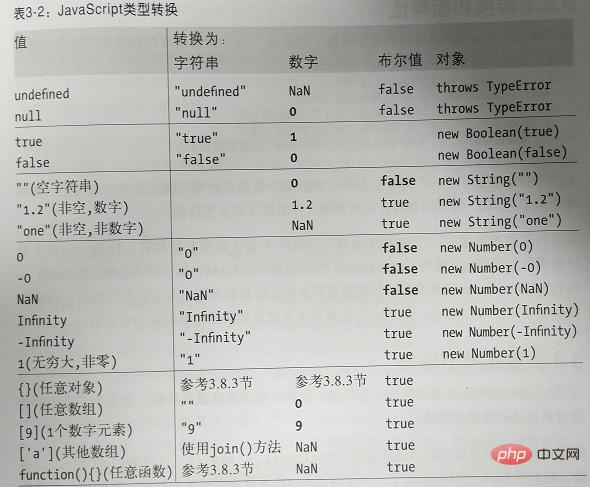How to convert type in javascript
Javascript type conversion method: 1. Use operators such as "==" and " " for implicit type conversion; 2. Use Boolean(), Number(), String(), Object(), Type conversion functions such as toString() and toFixed() perform explicit type conversion.

The operating environment of this tutorial: windows7 system, javascript version 1.8.5, Dell G3 computer.

1. Implicit type conversion
①==If two equal operations two variables are not of the same type, then the equality operator will try to do some type conversion:
- If one is null, the other is undefined, then they are equal ;
- If one value is a number and the other is a string, convert the string to a number first , and then use the converted value for comparison;
- If one is true, convert it to 1 and then compare, if one of If one is false, convert it to 0 and compare;
- If one value is an object and the other value is a number or string, Convert the object to the original value , then compare. The object is converted to a primitive value through the toString() or valueOf() method. The built-in classes in the core of the JS language first try to use valueOf() and then try to use toString(), except for the date class, which only uses toString() conversion.
- Other comparisons of different types are not equal.
②< > <= >= Comparison operator. The operands can be of any type, but only numbers and strings can actually perform comparison operations.
- If the operand is an object, the object is converted to a primitive value first: if valueOf() returns a primitive value, then the primitive value is used directly. Otherwise, use toString() conversion;
- After the object is converted to the original value, if both operands are strings, then compare according to the string;
- After the object is converted to a primitive value, if at least one of the operands is not a string, both are converted to numbers for comparison . If one of them is NaN, the result is false.
③- The subtraction operator converts both operands into numbers .
④ Addition operator, if one operand is a string, thenthe other operand will also be converted to a string. One dollar plus will convert its operand into a number.
⑤! Convert to Boolean value and negate it. !!x is equivalent to Boolean(x).
2. Explicit type conversion
①Use Boolean()/Number()/String()/Object() function. Any value except null and undefined has a toString() method, and the execution result of this method is usually the same as the return result of the String() method.
②Number to string
- toString() method, accepts parameters and compares them to decimal.
- toFixed(), the parameter indicates how many decimal places to keep.
- toExponential(), the parameter indicates how many decimal points to retain.
- toPrecision(), the parameter indicates the number of significant digits.
③Convert string to number
- parseInt() function
- parseFloat() function, are all global functions, not methods of any class .
④Convert the object to the original value
- toString() method.
The array class converts each element to a string and adds commas between elements to synthesize the string;
#The function class returns the implementation-defined representation of this function.
#The Date class returns a human-readable date and time string.
RegExp class converts to a direct literal.
- valueOf() method. If any primitive value exists for the object, it will default to converting the object to the primitive value that represents it. But objects are composite values, and in most cases valueOf() returns the object itself.
- To convert an object to a string, first use the toString() method, and to convert an object to a number, first use the valueOf() method.
[Related recommendations: javascript learning tutorial]
The above is the detailed content of How to convert type in javascript. For more information, please follow other related articles on the PHP Chinese website!

Hot AI Tools

Undresser.AI Undress
AI-powered app for creating realistic nude photos

AI Clothes Remover
Online AI tool for removing clothes from photos.

Undress AI Tool
Undress images for free

Clothoff.io
AI clothes remover

AI Hentai Generator
Generate AI Hentai for free.

Hot Article

Hot Tools

Notepad++7.3.1
Easy-to-use and free code editor

SublimeText3 Chinese version
Chinese version, very easy to use

Zend Studio 13.0.1
Powerful PHP integrated development environment

Dreamweaver CS6
Visual web development tools

SublimeText3 Mac version
God-level code editing software (SublimeText3)

Hot Topics
 1382
1382
 52
52
 How to implement an online speech recognition system using WebSocket and JavaScript
Dec 17, 2023 pm 02:54 PM
How to implement an online speech recognition system using WebSocket and JavaScript
Dec 17, 2023 pm 02:54 PM
How to use WebSocket and JavaScript to implement an online speech recognition system Introduction: With the continuous development of technology, speech recognition technology has become an important part of the field of artificial intelligence. The online speech recognition system based on WebSocket and JavaScript has the characteristics of low latency, real-time and cross-platform, and has become a widely used solution. This article will introduce how to use WebSocket and JavaScript to implement an online speech recognition system.
 WebSocket and JavaScript: key technologies for implementing real-time monitoring systems
Dec 17, 2023 pm 05:30 PM
WebSocket and JavaScript: key technologies for implementing real-time monitoring systems
Dec 17, 2023 pm 05:30 PM
WebSocket and JavaScript: Key technologies for realizing real-time monitoring systems Introduction: With the rapid development of Internet technology, real-time monitoring systems have been widely used in various fields. One of the key technologies to achieve real-time monitoring is the combination of WebSocket and JavaScript. This article will introduce the application of WebSocket and JavaScript in real-time monitoring systems, give code examples, and explain their implementation principles in detail. 1. WebSocket technology
 How to use JavaScript and WebSocket to implement a real-time online ordering system
Dec 17, 2023 pm 12:09 PM
How to use JavaScript and WebSocket to implement a real-time online ordering system
Dec 17, 2023 pm 12:09 PM
Introduction to how to use JavaScript and WebSocket to implement a real-time online ordering system: With the popularity of the Internet and the advancement of technology, more and more restaurants have begun to provide online ordering services. In order to implement a real-time online ordering system, we can use JavaScript and WebSocket technology. WebSocket is a full-duplex communication protocol based on the TCP protocol, which can realize real-time two-way communication between the client and the server. In the real-time online ordering system, when the user selects dishes and places an order
 How to implement an online reservation system using WebSocket and JavaScript
Dec 17, 2023 am 09:39 AM
How to implement an online reservation system using WebSocket and JavaScript
Dec 17, 2023 am 09:39 AM
How to use WebSocket and JavaScript to implement an online reservation system. In today's digital era, more and more businesses and services need to provide online reservation functions. It is crucial to implement an efficient and real-time online reservation system. This article will introduce how to use WebSocket and JavaScript to implement an online reservation system, and provide specific code examples. 1. What is WebSocket? WebSocket is a full-duplex method on a single TCP connection.
 Type conversion of golang function
Apr 19, 2024 pm 05:33 PM
Type conversion of golang function
Apr 19, 2024 pm 05:33 PM
In-function type conversion allows data of one type to be converted to another type, thereby extending the functionality of the function. Use syntax: type_name:=variable.(type). For example, you can use the strconv.Atoi function to convert a string to a number and handle errors if the conversion fails.
 JavaScript and WebSocket: Building an efficient real-time weather forecasting system
Dec 17, 2023 pm 05:13 PM
JavaScript and WebSocket: Building an efficient real-time weather forecasting system
Dec 17, 2023 pm 05:13 PM
JavaScript and WebSocket: Building an efficient real-time weather forecast system Introduction: Today, the accuracy of weather forecasts is of great significance to daily life and decision-making. As technology develops, we can provide more accurate and reliable weather forecasts by obtaining weather data in real time. In this article, we will learn how to use JavaScript and WebSocket technology to build an efficient real-time weather forecast system. This article will demonstrate the implementation process through specific code examples. We
 Simple JavaScript Tutorial: How to Get HTTP Status Code
Jan 05, 2024 pm 06:08 PM
Simple JavaScript Tutorial: How to Get HTTP Status Code
Jan 05, 2024 pm 06:08 PM
JavaScript tutorial: How to get HTTP status code, specific code examples are required. Preface: In web development, data interaction with the server is often involved. When communicating with the server, we often need to obtain the returned HTTP status code to determine whether the operation is successful, and perform corresponding processing based on different status codes. This article will teach you how to use JavaScript to obtain HTTP status codes and provide some practical code examples. Using XMLHttpRequest
 Implicit type conversion: An exploration of different variations of types and their applications in programming
Jan 13, 2024 pm 02:54 PM
Implicit type conversion: An exploration of different variations of types and their applications in programming
Jan 13, 2024 pm 02:54 PM
Explore the different types of implicit type conversions and their role in programming Introduction: In programming, we often need to deal with different types of data. Sometimes, we need to convert one data type to another type in order to perform a specific operation or meet specific requirements. In this process, implicit type conversion is a very important concept. Implicit type conversion refers to the process in which the programming language automatically performs data type conversion without explicitly specifying the conversion type. This article will explore the different types of implicit type conversions and their role in programming,




